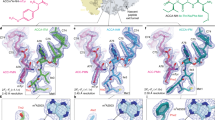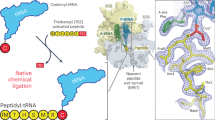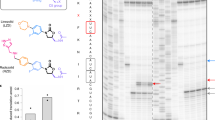Abstract
Protein synthesis is targeted by numerous, chemically distinct antibiotics that bind and inhibit key functional centers of the ribosome. Using single-molecule imaging and X-ray crystallography, we show that the aminoglycoside neomycin blocks aminoacyl–transfer RNA (aa-tRNA) selection and translocation as well as ribosome recycling by binding to helix 69 (H69) of 23S ribosomal RNA within the large subunit of the Escherichia coli ribosome. There, neomycin prevents the remodeling of intersubunit bridges that normally accompanies the process of subunit rotation to stabilize a partially rotated ribosome configuration in which peptidyl (P)-site tRNA is constrained in a previously unidentified hybrid position. Direct measurements show that this neomycin-stabilized intermediate is incompatible with the translation factor binding that is required for distinct protein synthesis reactions. These findings reveal the functional importance of reversible intersubunit rotation to the translation mechanism and shed new light on the allosteric control of ribosome functions by small-molecule antibiotics.
This is a preview of subscription content, access via your institution
Access options
Subscribe to this journal
Receive 12 print issues and online access
$189.00 per year
only $15.75 per issue
Buy this article
- Purchase on Springer Link
- Instant access to full article PDF
Prices may be subject to local taxes which are calculated during checkout





Similar content being viewed by others
References
Gale, E.F., Cundliffe, E., Reynolds, P.E., Richmond, M.H. & Waring, M.J. The Molecular Basis of Antibiotic Action, 2nd edn. (John Wiley & Sons Ltd., 1981).
Wilson, D.N. The A–Z of bacterial translation inhibitors. Crit. Rev. Biochem. Mol. Biol. 44, 393–433 (2009).
Blanchard, S.C., Cooperman, B.S. & Wilson, D.N. Probing translation with small-molecule inhibitors. Chem. Biol. 17, 633–645 (2010).
Poehlsgaard, J. & Douthwaite, S. The bacterial ribosome as a target for antibiotics. Nat. Rev. Microbiol. 3, 870–881 (2005).
Tenson, T. & Mankin, A. Antibiotics and the ribosome. Mol. Microbiol. 59, 1664–1677 (2006).
Nathan, C. Antibiotics at the crossroads. Nature 431, 899–902 (2004).
von Nussbaum, F., Brands, M., Hinzen, B., Weigand, S. & Habich, D. Antibacterial natural products in medicinal chemistry—exodus or revival? Angew. Chem. Int. Edn. Engl. 45, 5072–5129 (2006).
Fischbach, M.A. & Walsh, C.T. Antibiotics for emerging pathogens. Science 325, 1089–1093 (2009).
Llano-Sotelo, B., Hickerson, R.P., Lancaster, L., Noller, H.F. & Mankin, A.S. Fluorescently labeled ribosomes as a tool for analyzing antibiotic binding. RNA 15, 1597–1604 (2009).
David-Eden, H., Mankin, A.S. & Mandel-Gutfreund, Y. Structural signatures of antibiotic binding sites on the ribosome. Nucleic Acids Res. 38, 5982–5994 (2010).
Rodnina, M.V. et al. GTPases mechanisms and functions of translation factors on the ribosome. Biol. Chem. 381, 377–387 (2000).
Fourmy, D., Recht, M.I., Blanchard, S.C. & Puglisi, J.D. Structure of the A site of Escherichia coli 16S ribosomal RNA complexed with an aminoglycoside antibiotic. Science 274, 1367–1371 (1996).
Schmeing, T.M. & Ramakrishnan, V. What recent ribosome structures have revealed about the mechanism of translation. Nature 461, 1234–1242 (2009).
Zaher, H.S. & Green, R. Fidelity at the molecular level: lessons from protein synthesis. Cell 136, 746–762 (2009).
Davies, J., Gorini, L. & Davis, B.D. Misreading of RNA codewords induced by aminoglycoside antibiotics. Mol. Pharmacol. 1, 93–106 (1965).
Kurland, C.G. Translational accuracy and the fitness of bacteria. Annu. Rev. Genet. 26, 29–50 (1992).
Feldman, M.B., Terry, D.S., Altman, R.B. & Blanchard, S.C. Aminoglycoside activity observed on single pre-translocation ribosome complexes. Nat. Chem. Biol. 6, 54–62 (2010).
Hirokawa, G. et al. Post-termination complex disassembly by ribosome recycling factor, a functional tRNA mimic. EMBO J. 21, 2272–2281 (2002).
Davies, J. & Davis, B.D. Misreading of ribonucleic acid code words induced by aminoglycoside antibiotics. The effect of drug concentration. J. Biol. Chem. 243, 3312–3316 (1968).
Dahlberg, A.E., Horodyski, F. & Keller, P. Interaction of neomycin with ribosomes and ribosomal ribonucleic acid. Antimicrob. Agents Chemother. 13, 331–339 (1978).
Borovinskaya, M.A. et al. Structural basis for aminoglycoside inhibition of bacterial ribosome recycling. Nat. Struct. Mol. Biol. 14, 727–732 (2007).
Munro, J.B., Sanbonmatsu, K.Y., Spahn, C.M. & Blanchard, S.C. Navigating the ribosome's metastable energy landscape. Trends Biochem. Sci. 34, 390–400 (2009).
Valle, M. et al. Locking and unlocking of ribosomal motions. Cell 114, 123–134 (2003).
Frank, J. & Gonzalez, R.L. Jr. Structure and dynamics of a processive Brownian motor: the translating ribosome. Annu. Rev. Biochem. 79, 381–412 (2010).
Ortiz-Meoz, R.F. & Green, R. Helix 69 is key for uniformity during substrate selection on the ribosome. J. Biol. Chem. 286, 25604–25610 (2011).
Bulkley, D., Johnson, F. & Steitz, T.A. The antibiotic thermorubin inhibits protein synthesis by binding to inter-subunit bridge B2a of the ribosome. J. Mol. Biol. 416, 571–578 (2012).
Dunkle, J.A. et al. Structures of the bacterial ribosome in classical and hybrid states of tRNA binding. Science 332, 981–984 (2011).
Rodnina, M.V. & Wintermeyer, W. Fidelity of aminoacyl-tRNA selection on the ribosome: kinetic and structural mechanisms. Annu. Rev. Biochem. 70, 415–435 (2001).
Geggier, P. et al. Conformational sampling of aminoacyl-tRNA during selection on the bacterial ribosome. J. Mol. Biol. 399, 576–595 (2010).
Ogle, J.M. & Ramakrishnan, V. Structural insights into translational fidelity. Annu. Rev. Biochem. 74, 129–177 (2005).
Recht, M.I., Douthwaite, S. & Puglisi, J.D. Basis for prokaryotic specificity of action of aminoglycoside antibiotics. EMBO J. 18, 3133–3138 (1999).
Munro, J.B., Wasserman, M.R., Altman, R.B., Wang, L. & Blanchard, S.C. Correlated conformational events in EF-G and the ribosome regulate translocation. Nat. Struct. Mol. Biol. 17, 1470–1477 (2010).
Hirokawa, G. et al. The role of ribosome recycling factor in dissociation of 70S ribosomes into subunits. RNA 11, 1317–1328 (2005).
Munro, J.B., Altman, R.B., Tung, C.S., Sanbonmatsu, K.Y. & Blanchard, S.C. A fast dynamic mode of the EF-G–bound ribosome. EMBO J. 29, 770–781 (2010).
Fei, J., Kosuri, P., MacDougall, D.D. & Gonzalez, R.L. Jr. Coupling of ribosomal L1 stalk and tRNA dynamics during translation elongation. Mol. Cell 30, 348–359 (2008).
Munro, J.B. et al. Spontaneous formation of the unlocked state of the ribosome is a multistep process. Proc. Natl. Acad. Sci. USA 107, 709–714 (2010).
Zhang, W., Dunkle, J.A. & Cate, J.H. Structures of the ribosome in intermediate states of ratcheting. Science 325, 1014–1017 (2009).
Sternberg, S.H., Fei, J., Prywes, N., McGrath, K.A. & Gonzalez, R.L. Jr. Translation factors direct intrinsic ribosome dynamics during translation termination and ribosome recycling. Nat. Struct. Mol. Biol. 16, 861–868 (2009).
Laurberg, M. et al. Structural basis for translation termination on the 70S ribosome. Nature 454, 852–857 (2008).
Petry, S., Weixlbaumer, A. & Ramakrishnan, V. The termination of translation. Curr. Opin. Struct. Biol. 18, 70–77 (2008).
Cornish, P.V. et al. Following movement of the L1 stalk between three functional states in single ribosomes. Proc. Natl. Acad. Sci. USA 106, 2571–2576 (2009).
Fei, J. et al. Allosteric collaboration between elongation factor G and the ribosomal L1 stalk directs tRNA movements during translation. Proc. Natl. Acad. Sci. USA 106, 15702–15707 (2009).
Peske, F., Savelsbergh, A., Katunin, V.I., Rodnina, M.V. & Wintermeyer, W. Conformational changes of the small ribosomal subunit during elongation factor G-dependent. tRNA-mRNA translocation. J. Mol. Biol. 343, 1183–1194 (2004).
Stanley, R.E., Blaha, G., Grodzicki, R.L., Strickler, M.D. & Steitz, T.A. The structures of the anti-tuberculosis antibiotics viomycin and capreomycin bound to the 70S ribosome. Nat. Struct. Mol. Biol. 17, 289–293 (2010).
Cornish, P.V., Ermolenko, D.N., Noller, H.F. & Ha, T. Spontaneous intersubunit rotation in single ribosomes. Mol. Cell 30, 578–588 (2008).
Ermolenko, D.N. et al. The antibiotic viomycin traps the ribosome in an intermediate state of translocation. Nat. Struct. Mol. Biol. 14, 493–497 (2007).
Jin, H., Kelley, A.C. & Ramakrishnan, V. Crystal structure of the hybrid state of ribosome in complex with the guanosine triphosphatase release factor 3. Proc. Natl. Acad. Sci. USA 108, 15798–15803 (2011).
Ratje, A.H. et al. Head swivel on the ribosome facilitates translocation by means of intra-subunit tRNA hybrid sites. Nature 468, 713–716 (2010).
Wang, L., Altman, R.B. & Blanchard, S.C. Insights into the molecular determinants of EF-G catalyzed translocation. RNA 17, 2189–2200 (2011).
Chan, Y.L. & Wool, I.G. The integrity of the sarcin/ricin domain of 23 S ribosomal RNA is not required for elongation factor-independent peptide synthesis. J. Mol. Biol. 378, 12–19 (2008).
Whitford, P.C. et al. Excited states of ribosome translocation revealed through integrative molecular modeling. Proc. Natl. Acad. Sci. USA 108, 18943–18948 (2011).
Gao, Y.G. et al. The structure of the ribosome with elongation factor G trapped in the posttranslocational state. Science 326, 694–699 (2009).
Schmeing, T.M. et al. The crystal structure of the ribosome bound to EF-Tu and aminoacyl-tRNA. Science 326, 688–694 (2009).
Aitken, C.E. & Puglisi, J.D. Following the intersubunit conformation of the ribosome during translation in real time. Nat. Struct. Mol. Biol. 17, 793–800 (2010).
Fei, J., Richard, A.C., Bronson, J.E. & Gonzalez, R.L. Jr. Transfer RNA–mediated regulation of ribosome dynamics during protein synthesis. Nat. Struct. Mol. Biol. 18, 1043–1051 (2011).
Ruggero, D. & Pandolfi, P.P. Does the ribosome translate cancer? Nat. Rev. Cancer 3, 179–192 (2003).
Andersson, D.I., Bohman, K., Isaksson, L.A. & Kurland, C.G. Translation rates and misreading characteristics of rpsD mutants in Escherichia coli. Mol. Gen. Genet. 187, 467–472 (1982).
O'Connor, M., Goringer, H.U. & Dahlberg, A.E. A ribosomal ambiguity mutation in the 530 loop of E. coli 16S rRNA. Nucleic Acids Res. 20, 4221–4227 (1992).
Davis, B.D. Mechanism of bactericidal action of aminoglycosides. Microbiol. Rev. 51, 341–350 (1987).
Hobbie, S.N. et al. Binding of neomycin-class aminoglycoside antibiotics to mutant ribosomes with alterations in the A site of 16S rRNA. Antimicrob. Agents Chemother. 50, 1489–1496 (2006).
The PyMOL molecular graphics system. Version 1.3 (Schrödinger, LLC, 2002).
Yin, J., Lin, A.J., Golan, D.E. & Walsh, C.T. Site-specific protein labeling by Sfp phosphopantetheinyl transferase. Nat. Protoc. 1, 280–285 (2006).
Cukras, A.R., Southworth, D.R., Brunelle, J.L., Culver, G.M. & Green, R. Ribosomal proteins S12 and S13 function as control elements for translocation of the mRNA:tRNA complex. Mol. Cell 12, 321–328 (2003).
Dave, R., Terry, D.S., Munro, J.B. & Blanchard, S.C. Mitigating unwanted photophysical processes for improved single-molecule fluorescence imaging. Biophys. J. 96, 2371–2381 (2009).
Munro, J.B., Altman, R.B., O'Connor, N. & Blanchard, S.C. Identification of two distinct hybrid state intermediates on the ribosome. Mol. Cell 25, 505–517 (2007).
Blaha, G. et al. Preparation of functional ribosomal complexes and effect of buffer conditions on tRNA positions observed by cryoelectron microscopy. Methods Enzymol. 317, 292–309 (2000).
Kabsch, W. XDS. Acta Crystallogr. D Biol. Crystallogr. 66, 125–132 (2010).
Adams, P.D. et al. PHENIX: a comprehensive Python-based system for macromolecular structure solution. Acta Crystallogr. D Biol. Crystallogr. 66, 213–221 (2010).
Emsley, P., Lohkamp, B., Scott, W.G. & Cowtan, K. Features and development of Coot. Acta Crystallogr. D Biol. Crystallogr. 66, 486–501 (2010).
Chen, V.B., Davis, I.W. & Richardson, D.C. KING (Kinemage, Next Generation): a versatile interactive molecular and scientific visualization program. Protein Sci. 18, 2403–2409 (2009).
Saenger, W. Principles of Nucleic Acid Structure (Springer-Verlag, New York, 1984).
Qin, F., Auerbach, A. & Sachs, F. Estimating single-channel kinetic parameters from idealized patch-clamp data containing missed events. Biophys. J. 70, 264–280 (1996).
Acknowledgements
We thank R. Green (Johns Hopkins University) for providing the S13 knockout mouse strain, T. Suzuki (University of Tokyo) for providing the pKK3535 ribosome plasmids, K. Hamadani (University of California, Berkeley) for the RRF expression vector and M. O'Connor (University of Missouri-Kansas City) for helpful discussions throughout the course of this work. We also acknowledge helpful discussions and insights provided by all members of the Blanchard and Cate laboratories and J. Headd (Lawrence Berkeley National Laboratory) for help with PHENIX refinement. This work was supported by the US National Institutes of Health (2R01GM079238 to S.C.B., 1R01GM65050 to J.H.D.C. and National Cancer Institute grant CA92584 for the SIBYLS and 8.3.1 beamlines at the Advanced Light Source (ALS), Lawrence Berkeley National Laboratory), the Human Frontiers in Science Program (RGY0088), the National Science Foundation (0644129) and the US Department of Energy (DE-AC0376SF00098 for the SIBYLS and 8.3.1 beamlines at the ALS, Lawrence Berkeley National Laboratory). M.B.F. is a trainee in the Weill Cornell/Rockefeller University/Sloan-Kettering Tri-Institutional MD/PhD Program supported by US National Institutes of Health Medical Scientist Training Program grant GM07739. M.R.W. is supported by US National Institutes of Health National Research Service Award fellowship 5F31DC012026-02.
Author information
Authors and Affiliations
Contributions
L.W. and M.R.W. prepared dye-labeled ribosomes, tRNAs and translation factors and performed the smFRET imaging and analyzed the results. A.P. crystallized, collected, processed and refined X-ray data. L.W. and M.B.F. performed and analyzed bulk functional assays. L.W. and A.P. made the figures. R.B.A. prepared reagents crucial for smFRET experiments. S.C.B. and J.H.D.C. designed the study. All authors discussed the results and contributed to the writing of the manuscript.
Corresponding authors
Ethics declarations
Competing interests
The authors declare no competing financial interests.
Supplementary information
Supplementary Text and Figures
Supplementary Figures 1–5. (PDF 893 kb)
Rights and permissions
About this article
Cite this article
Wang, L., Pulk, A., Wasserman, M. et al. Allosteric control of the ribosome by small-molecule antibiotics. Nat Struct Mol Biol 19, 957–963 (2012). https://doi.org/10.1038/nsmb.2360
Received:
Accepted:
Published:
Issue Date:
DOI: https://doi.org/10.1038/nsmb.2360
This article is cited by
-
Geometric alignment of aminoacyl-tRNA relative to catalytic centers of the ribosome underpins accurate mRNA decoding
Nature Communications (2023)
-
The case of the missing allosteric ribozymes
Nature Chemical Biology (2021)
-
Multiplexed genomic encoding of non-canonical amino acids for labeling large complexes
Nature Chemical Biology (2020)
-
Structural basis for ribosome recycling by RRF and tRNA
Nature Structural & Molecular Biology (2020)
-
Destination of aminoglycoside antibiotics in the ‘post-antibiotic era’
The Journal of Antibiotics (2018)



